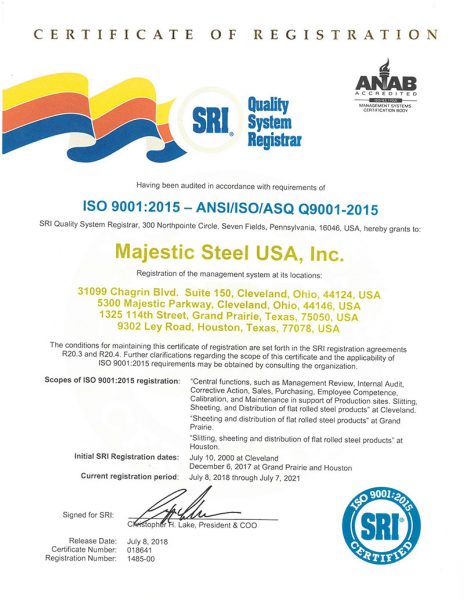Market Update | November 1, 2023
THE UAW HAS COME TO TENTATIVE AGREEMENTS WITH THE BIG 3 AUTO PRODUCERS
After last week’s tentative agreement with Ford, the UAW has now reached tentative agreements with all three major auto producers, including Stellantis and GM. The agreement with Stellantis was reached over the weekend, and the agreement with GM was reached at the beginning of this week. With tentative agreements in place at all the Big 3 producers, full auto production is expected to ramp up.
Input Costs
After rebounding last week, zinc pricing declined this week on the back of a strengthening US dollar.
- Zinc pricing increased to $1.10/lb this week but has remained in a relatively tight range for the past month.
- The average over the past 30 days is $1.11/lb.
Iron ore pricing rebounded this week on the anticipation of a new round of stimulus announcements from China.
- Spot iron ore pricing came in at $123/mt, closing in on its highest level since April.
Met coal pricing increased slightly this week, climbing to $350/mt on increased demand from China.
- This is up 1.5% from last week and is up 7.4% from this time last month.
Supply
US raw steel production increased slightly this week, now up in back-to-back weeks.
- US steelmakers produced 1.707 million tons at a 74.3% utilization rate.
- A 20k st production increase from the South region was more than enough to overcome the combined decline of 18k st from the Great Lakes, West, and Midwest regions.
- The current YTD utilization rate is at 75.9%, down 0.9% compared to the same time last year.
After the sharp increase in September (due to HRC), preliminary October carbon flat rolled imports are down 22.9% compared to September.
- Preliminary carbon flat rolled imports are on track to have their lowest monthly total since April.
- Coated flat rolled imports are down as well, sliding 7.9% compared to the daily pace in September.
DEMAND
Ford and the UAW have come to a tentative agreement that would end the strike after 41 days.
- Over the weekend and at the beginning of this week, the UAW struck tentative agreements with both Stellantis and GM.
- With tentative agreements at all the Big 3 producers, full auto production is expected to ramp up.
Manufacturing activity, in the Chicagoland region, continued to slide in October, now in contraction for fourteen consecutive months.
- The October Chicago PMI came in at 44.0, down from 44.1 in September and is at its lowest level since July.
- Any reading below 50 denotes contraction, while any reading over 50 shows expansion.
- The production component saw the largest decline in October, sliding 4.6 to 46.5.
- The deliveries and order backlog components slipped as well, sliding 0.5 and 0.3, respectively.
- The new order component increased 4.2 after a sharp 17.6 decline in September.
Economic activity in the manufacturing sector, contracted in October, is now in contraction for the twelfth consecutive month.
- The ISM Manufacturing PMI came in at 46.7 in October, down from 49.0 in September.
- The October PMI is below the rolling twelve-month average of 47.4 as well.
- The twelve-month average is at its lowest level since December 2009.
- Both the new order and production components declined, sliding by 3.7 and 2.1 points, respectively.
- Despite the decline in production, it remained in slight expansion at 50.4.
- The backlog of orders component came in at 42.2, down from 42.4 previously.
Total construction spending continued to climb in September and has climbed now for the ninth consecutive month.
- Total spending came in at a $1.997 trillion rate, up 0.4% from August and up 8.7% from the $1.837 trillion rate in September 2022.
- The 8.7% year-over-year increase in September was the highest since January.
- Spending on both residential and non-residential projects increases from September, climbing 0.6% and 01%, respectively.
- Looking on a year-over-year basis, however, non-residential spending saw a sharp 21.3% increase while residential spending fell 2.1%.
- Residential spending has now declined, on a year-over-year basis, for nine consecutive months.
ECONOMIC
Confidence among U.S. consumers continued to weaken in October, now down for the third consecutive month.
- According to The Conference Board, October Consumer Confidence slipped to 102.6, down from a revised 104.3 in September.
- The present situation component declined to 143.1, down a little over 3.0 points from September.
- The expectations component declined to 75.6 from 76.4 previously.
- The expectation component remained below 80.0, the level that historically signals a recession within the next year.
- Rising prices overall, but for food and gasoline specifically, negatively impacted consumers in October.
- Other concerns included the political situation and higher interest rates.
This material, information and analyses (the “Content”) may include certain statements, estimates and projections prepared with respect to, among other things, historical data and anticipated performance. Content may reflect various assumptions by Majestic Steel USA, Inc. concerning anticipated results that are inherently subject to significant economic, competitive and other uncertainties and contingencies and have been included for illustrative purposes. Content is provided AS-IS.

